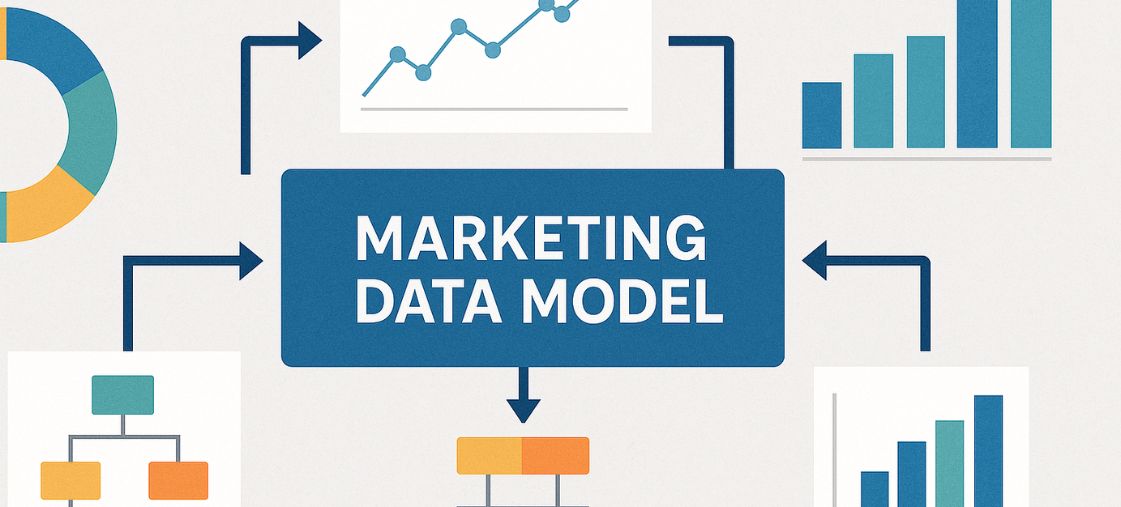
Building Marketing Data Models: A Complete, Practical Guide
Marketing data models are the blueprint that turn messy channel data into reliable, decision-ready insights that improve budget allocation, targeting, and growth.
Before you open a notebook or your favorite BI tool, it helps to ground your approach in a proven, step-by-step framework. For a perspective on sequencing and stakeholder alignment, this step-by-step guide is a helpful primer you can cross-reference as you design your own workflows.
Well-constructed models bring consistency to reporting, reduce time-to-insight, and make experimentation safer. They create a shared language between marketing, data teams, and finance so that acquisition metrics, LTV, and incrementality can be compared apples-to-apples across campaigns and cohorts.
At a high level, your goal is to design a reliable transformation pipeline from raw events to analytical tables and predictive outputs. If you are new to the space, review foundational concepts in customer data analytics to orient how identities, attributes, and behaviors come together to support modeling.

What is a marketing data model?
A marketing data model is a documented structure describing the entities, relationships, transformations, and business rules that convert raw marketing signals (impressions, clicks, visits, conversions, revenue) into trustworthy analytical artifacts. In practice, it’s the combination of:
- Semantic layer: definitions for KPIs (e.g., sessions, assisted conversions, CAC, ROAS, ROMI).
- Data structures: fact tables (events, spend, conversions) and dimensions (channel, campaign, creative, audience, device, geo).
- Transformations: de-duplication, normalization, timestamp harmonization, currency and timezone handling.
- Governance: data contracts, data quality tests, ownership, and documentation.
Key benefits of building it right
- Consistent truth: one version of spend, revenue, and attribution everyone trusts.
- Faster learning cycles: standardized schemas make cohorting and experiment readouts much faster.
- Cross-channel comparability: normalize names, costs, and conversions to evaluate performance fairly.
- Predictive readiness: clean feature stores enable LTV prediction, churn likelihood, and propensity scoring.
- Compliance and resilience: clear data lineage and contracts reduce breakage when APIs change.
Prerequisites and success criteria
Data readiness
- Source access: ad platforms, web/app analytics, CRM, billing, and product events.
- Identity strategy: deterministic IDs (user_id, email hash) and rules for conflict resolution.
- Time discipline: UTC storage, explicit timezones for reporting, iso8601 formats.
- Granularity choice: daily/hourly tables with clear aggregation rules.
Team alignment
- Clear owners for ingestion, modeling, QA, and business definitions.
- Documented acceptance criteria for each table and KPI.
- Change management: versioning and a lightweight RFC process for metric changes.
Core building blocks
1) Sources and ingestion
Start with a source inventory: ad platforms (Google, Meta, TikTok, LinkedIn), analytics (GA4, Snowplow), product events, CRM, and finance. Use incremental extraction where possible and include soft-delete handling so backfills don’t create duplicates.
2) Raw to staged
Land raw data unchanged. Create a staged layer that lightly standardizes field names and types, handles nulls, and normalizes currencies and timezones. Keep a strict separation so you can reprocess transformations without re-pulling APIs.
3) Modeled fact and dimension tables
- Fact_spend: one row per platform-campaign-adset-ad-date with cost, clicks, impressions.
- Fact_events: one row per user/session event with timestamp, identity, and event_type.
- Fact_conversions: one row per order/goal with value, currency, attribution markers.
- Dim_campaign: standardized keys for channel, campaign, creative, audience, geo.
4) Semantic layer
Define KPIs once and reuse them. For example, standardize ROAS = revenue / cost and CAC = cost / new_customers, and document edge cases like refunds, partial orders, or repeated trials.
Identity resolution and attribution
Identity stitching is often the hardest part. Prioritize deterministic matches (login, hashed email) and use hierarchical rules to roll up device IDs and cookies to a person-level ID. For attribution, maintain both last-touch and data-driven models; the former supports continuity with legacy dashboards, while the latter offers a truer incrementality signal.
Practical tips
- Store all touchpoints with timestamps so windows can be changed later without reprocessing.
- Tag touches by channel, campaign, creative, and position in the path.
- Calculate multiple lookbacks (e.g., 7/28/90-day) and keep them side-by-side for comparison.
Feature engineering for predictive models
Once your modeling layer is stable, curate a feature store that aggregates behaviors at user, account, and cohort levels. Examples include recency/frequency/monetary signals; average order value; session depth; email engagement; and paid touch diversity. Encode seasonality with calendar features and consider lagged variables for channel spend to capture delayed effects.
- LTV prediction: survival models or gradient boosting with features from the first 7–30 days.
- Churn propensity: classification with recency, support tickets, and product usage decay.
- Conversion propensity: session- and user-level features for retargeting and lifecycle flows.
Model evaluation and guardrails
Choose metrics aligned with the decision you’re trying to make. For binary outcomes, monitor ROC-AUC, PR-AUC, calibration, and profit curves. For regression, Track MAPE, RMSE, and MASE. Add governance gates: train/validation splits by time, leakage checks, and unit tests for metric definitions. Promote models only when they outperform simple baselines and remain stable across cohorts.
Operationalizing and monitoring
Productionizing marketing data models means reproducible pipelines, scheduled runs, and monitoring. Add freshness and volume tests at each layer, compare key KPI deltas day-over-day, and alert on anomalies. Document SLAs for availability and recovery, and keep rollback scripts ready when a new definition ships.
Data reliability checklist
- Ingestion success and latency per source.
- Row count thresholds and duplicate checks.
- Schema drift detection and contract enforcement.
- Metric parity versus platform-of-record benchmarks.
Model performance checklist
- Weekly drift review for features and predictions.
- Backtesting against new cohorts every month.
- Shadow deployments and canary rollouts for new versions.
- Cost-to-serve monitoring (compute, storage, inference).
Data contracts and documentation
Document every table with purpose, column definitions, owners, and example queries. Attach contracts to upstream teams or vendors that specify minimum fields, data types, and delivery schedules. Treat KPI definitions as code: version them, review changes, and tag downstream dashboards and models with the definition version they were built against.
Common pitfalls and how to avoid them
- Unstable IDs: solve with deterministic identity first and explicit fallback rules.
- Mismatched timezones: store in UTC, convert at the edges, and document the policy.
- Metric drift: lock definitions behind a review process and communicate changes broadly.
- Overfitting: control complexity, cross-validate by time, and keep a naive baseline.
- Dependency sprawl: prefer a few well-structured tables over many ad-hoc marts.
Example schema pattern
fact_spend(date, platform, campaign_key, adset_key, ad_key, impressions, clicks, cost_usd)
fact_event(event_time, user_id, session_id, event_type, source, campaign_key)
fact_conversion(order_id, user_id, order_time, revenue_usd, attribution_model, campaign_key)
dim_campaign(campaign_key, channel, campaign_name_std, creative_name_std, audience_name_std, geo)
kpi_semantic(kpi_name, sql_definition, owner, version, description)
From insights to action
Model outputs should drive decisions: budget reallocation by marginal ROAS, creative iteration based on audience lift, and lifecycle triggers keyed off propensity scores. Close the loop by pushing predictions into ad platforms or marketing automation and measuring uplift through controlled experiments. Keep a living playbook that maps each model to the business decision it enables and the KPI it should move.
Conclusion
Building robust marketing data models is less about fancy algorithms and more about disciplined definitions, clean pipelines, and a culture of measurement. Start simple, document aggressively, test continuously, and only add complexity when it earns its keep. As your program scales, consider specialized tools—ranging from data quality checks to competitive intelligence—to deepen insights and sharpen execution. With these practices, you’ll produce models that stakeholders trust and that reliably translate data into growth.


